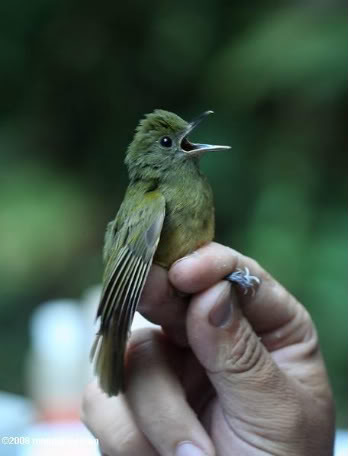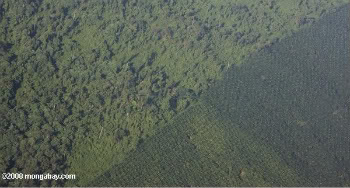|
|
“I want to convince you we need to go beyond primary forests to preserve biodiversity”, Robin Chazdon told an audience at the National Natural History Museum during a symposium on the tropics.
Chazdon, a professor of ecology and evolutionary biology at the University of Connecticut, has been studying secondary growth forests for over eighteen years. Secondary forests are those forests in the process of regrowth after being used for agriculture or logging. In her study area of NE Costa Rica, many of these forests were converted to pastures in the 1970s and 1980s, but have since been abandoned. In her presentation Chazdon argued that to preserve biodiversity numerous types of human-impacted landscapes, such as secondary forest, require attention by the conservation community.
 Recent studies have shown that secondary forests retain a significant amount of bird diversity. Here an ochre-headed flycatcher from Costa Rica. |
Such a statement may seem obvious when Chazdon points out that 90 percent of the world’s tropical forests exist outside of protected reserves, but so far there have been few conservation initiatives focusing on secondary forests, agroforestry, or other human-modified areas. Perhaps that is because most human-modified areas in the tropics have largely been considered hostile to biodiversity. However, a series of studies done in the last few years have painted a very different picture.
In a large sample of secondary forests from 10-45 years old in Costa Rica, scientists discovered 90 percent of tree species found in old-growth forest areas were represented either by seedlings, small trees, or large trees. Chazdon describes such forests as “works in progress”—the number of species increase as time goes by, allowing biodiversity to recover faster than many expected. A similar study in Jari, Brazil of secondary forest found less diversity of trees—35 percent of mature forest species—however Chazdon points out that the study only counted trees and not seedlings. In addition the study area was relatively young. Currently, 42 tropical nations have higher areas of secondary and degraded forest than primary forest, creating urgency as to how conservation groups and governments should respond to this new trend of regeneration.
While secondary forests are becoming increasingly important for biodiversity, agroforestry has also proven effective in retaining biodiversity while in addition serving human needs. Agroforestry combines tree planting or forest components with the growth of products for human consumption. In many parts of the world this is the traditional style of agriculture, practiced for millennia before modern clear-cutting and industrial agriculture became the norm.
In Veracruz, Mexico a study found that bird diversity was actually greater in shade grown coffee farms than in the forest. This larger diversity was due to the shade grown coffee farms retaining a large percentage of bird forest species while attracting non-forest species as well. Pointing out that in Mesoamerica 80 percent of forest has been converted by humans to some extent, Chazdon told the audience “these are the areas where we need to conserve most of our biodiversity”.
In the Western Ghats of India, where cultivation has occurred for 2,000 years, areca nut agriculture retains 90 percent of the bird diversity of the native forests in the region. Most of these studies have focused on bird or tree species, since these are the easiest to survey. However a study done in the largely devastated Atlantic Forest of Brazil where only 6.5 percent of primary forest remains, showed that there was reason to be optimistic about agroforestry protecting more than bird and tree species. The study found that cacao (for the production of chocolate) grown under the canopy provides homes for 70 percent of many species, including birds, bats, butterflies, mammals, ferns, lizards and frogs.
Chazdon noted that agroforestry can be a “mixed story but still can protect many forest-requiring species in ecosystems, while still allowing agricultural production”.
Conservationists also “tend to write-off pasture landscapes from a biological perspective,” yet even pasture is not barren. In a study done in pasture land in Nicaragua, a surprising 46 forest tree species were found, many of which are homes to various birds, bats, and insects. With this information Chazdon concluded that pasture was at least much better than soy farms.
 Clear-cut forest becomes an oil-palm plantations. Oil-palm under current growing techniques is notorious for having little biodiversity. |
Chazdon did not want the audience to go away with the message that all human-modified landscapes are equal or even notable in preserving biodiversity. Some landscapes were simply devastating for wildlife, she said. For example soybean fields are “devoid of biodiversity” and “astonishingly poor” biodiversity exists in palm oil plantations. Palm oil plantations have been shown to retain a paltry 15 percent of species from the lost forest. But palm oil plantations have run rampant over Asian tropical forests in the last couple decades; currently 13 million hectares have replaced natural forests, greatly threatening Asian wildlife.
Chazdon drew up a list of important focal points for future conservation efforts, from most effective to least: remnant primary growth forest patches, riparian strips, secondary forests, agroforestry, plantations, and living fences. Such ‘fences’ are actually corridors in pastures which allow the movement of birds, bats, primates, and insects among vegetation patches. While her talk illuminated the importance of secondary forest for preserving biodiversity, Chazdon stated that she “wouldn’t protect secondary forest cover over primary forest”. Some tropical regions do not have enough remaining forest cover to support diverse secondary regrowth; in these cases tree planting and active reforestation are needed to restore forest cover.
Chazdon hoped that conservation groups and governments would do more to advocate for agroforestry and indigenous agriculture that has been practiced for centuries in harmony with surrounding forests. At the same time, she wants to change the minds of biologists so that they stop seeing secondary forests as degraded and barren, but rather they imagine with accuracy what the landscape could look like in only a couple decades. Secondary forest is particularly vulnerable and so requires oversight and protection if it is to reach its potential.
Such efforts require a “perspective on conservation that is forward looking” with “protected areas as the backbone of conservation strategy while modified landscape should represent the rest of the skeleton,” Chazdon said. In addition to speaking at the Smithsonian symposium, Chazdon brought the same message to one of the world’s most powerful environmental organizations, Conservation International.
“If we can protect, expand, and enhance forest cover in these altered landscapes, the prognosis for conserving many forms of plant and animal life will improve in many regions,” Chazdon told the media. “It doesn’t have to be black and white. In many places, the gray areas are our best hope for retaining tropical biodiversity.”
If secondary forests are to survive, pollinators will be essential. The 5th Annual Frugivore and Seed Dispersal Symposium in 2010 will cover this issue in great detail: http://www.fsd2010.org/
Previous articles
Symposium tackles big question: how many species will survive our generation
(01/16/2009)
Nine scientists dusted off their crystal balls Monday at the National Museum of Natural History in Washington DC, weighing in on the future of the world’s tropical forest. Despite the most up-to-date statistics, prognosis for the future of tropical forests varied widely.
Carbon market could pay poor farmers to adopt sustainable cultivation techniques
(11/26/2008)
The emerging market for forest carbon could support agroforestry programs that alleviate rural poverty and promote sustainable development, states a new report issued by the World Agroforestry Center (ICRAF).
Large-scale agriculture ‘compromises’ forest’s ability to recover: An Interview with Dr. Robin Chazdon an expert on Tropical Forest Regeneration
(11/19/2007)
In an interview with mongabay.com, Dr. Chazdon talks of her hopes and fears surrounding the state of contemporary forests. While she sees the rise of large-scale agriculture as tropical forest’s greatest threat, she finds hope in her work on regenerating secondary forests and her frequent travels to Costa Rica, one of the world’s leading tropical nations in conservation. However, she stresses that forests may never recover from large-scale agriculture and even the tropics of Costa Rica face many dangers. Conservation of tropical forests still has a long road to go.
In the Amazon, primary forest biodiversity tops that of secondary forest, plantations
(11/12/2007)
Plantations and secondary forests are no match for primary Amazon rainforest in terms of biodiversity, reports the largest ever assessment of the biodiversity conservation value in the tropics.
Farming in the rainforest can preserve biodiversity, ecological services
(03/05/2007)
While conversion of tropical forest for agriculture results in significant declines in biodiversity and carbon storage, an analysis of Indonesian rainforests shows that farming cacao under the partial shade of high canopy trees can provide a way to balance economic gain with environmental considerations.